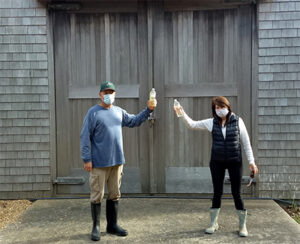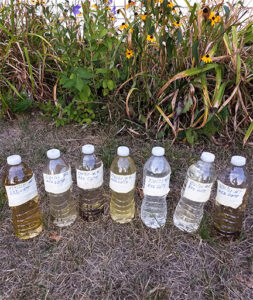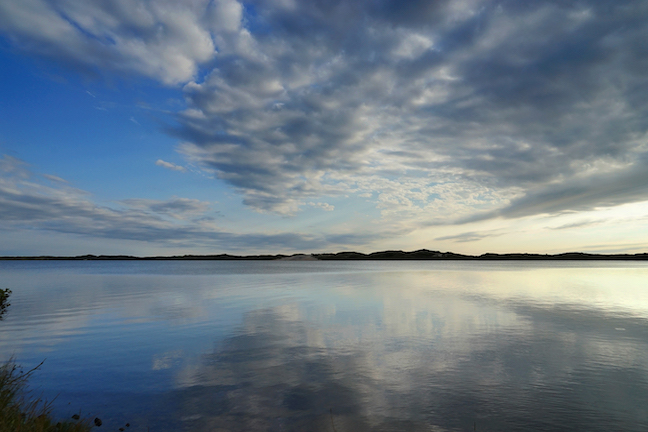By Kate Feiffer
The last day of August felt like an unremarkable end to a most unusual summer. It was a calm day with temperatures reaching the mid-seventies. Cormorants stretched their wings on Lily Pond and striped bass swam off the shore of Squibnocket, as did bluefish, Atlantic menhaden, cunner, sand lance, northern kingfish, snake eel, striped cusk eel, black sea bass, American butterfish, and clearnose skate.
Thanks to innovations in the world of marine environmental DNA (eDNA), the above list of fish is factual, and not the imaginings of a writer staring out over the ocean. With only a liter of water (collected from the ocean, or a pond, brook, or river) there is now a relatively easy and inexpensive technique available which can decipher DNA and detect which vertebrates have been in that water during the previous 48-hours.
Rockefeller University biologist and part-time Vineyard resident Jesse Ausubel has been working with his colleague Mark Stoeckle since 2014 on developing the process of aquatic eDNA analysis. Ausubel has explained that what you can now ascertain from just a liter of water is “comparable to what you get from sieving with a giant net (trawling) 66 million liters. That’s a football stadium up to the top of the goal posts.” In a recent article by Stoeckle and Ausubel in Sea Technology, they call it “The eDNA Revolution,” writing, “It revolutionizes the ability for people to know, affordably, what lives in the waters near them.”
According to the U.S. Geological Survey, “Environmental DNA originates from cellular material shed by organisms (via skin, excrement, etc.) into aquatic or terrestrial environments that can be sampled and monitored using new molecular methods.” Ausubel has likened the DNA shed to dandruff.

Jesse Ausubel and Lisa Foster
The DNA results obtained in the lab at Rockefeller University are then compared to sequences in a database called GenBank, which is maintained by the US Government. The numbers on the graph refer to what can be thought of as pieces of DNA that correspond to specific species not the number of actual fish found, which means the 40,988 under American eel at Squibnocket North doesn’t mean there could be over 40,000 eels slithering around your ankles. Ausubel explained, “We match these long strings of letters, which we know are vertebrate DNA, and we’ll get 40,988 reads of 110 letter sequences that are American eel.”

eDNA from Squibnocket Pond Reservation on August 31, 2020. Courtesy of Jesse Ausubel and Mark Stoeckle.
Ausubel pointed out that DNA from six species of fish, including white perch and nine-spined stickleback, were found in water taken from the north side of Squibnocket Pond, while water from the south side detected seven species—there weren’t any traces of striped killifish or sheepshead minnow on the north side. There was not much by way of fish in the water collected from Lily Pond, only banded killifish. The pond was placid on August 31st, so whatever DNA traces were in the water remained stagnant.
Golden shiners were found in Black Pond and American eel (the count here was an impressive 77,992) and mummichog were detected in Black Brook south.
“You can detect eleven species of fish from the foamy surf coming up on the beach at Squibnocket. That seems like magic,” marveled Ausubel. Findings on August 31st off of Squibnocket beach included plentiful striped bass, but fewer bluefish, although there were large numbers of the smaller fish that bluefish tend to eat.

Collected water samples
But why is this necessary? Why should we care? One reason is that our water sources are being impacted by continued development on the Island and climate change. This past summer, for the second summer in a row, toxic blue-green algae blooms were found in Chilmark Pond and through monitoring aquatic life one could further analyze the effects of the algae on the presence and abundance of other forms of life, ranging from fish to birds.For people tracking climate change, it is a useful tool to detect if southern species are showing up further north, whether invasive species have been introduced, and how storms impact the fish population around the Island. Swimmers could be alerted if great white shark DNA is found and flycasters could have a bit of a heads up on what might be biting. And it’s not just fish being found. Birds from the thrasher family, muskrats, cormorants, voles, frogs, racoons, seagulls and ducks were a few of the more visible vertebrates detected.
Ausubel noted that the results from this sample provide information from one day during one summer, but with additional testing throughout the year, which he hopes can happen in the near future, a more comprehensive understanding of aquatic life on Sheriff’s Meadow properties and elsewhere of the Vineyard can be achieved.
Feature photo by Steve Chapman


